Growth Response of Tartary Buckwheat to Plastic Mulching and Fertilization on Semiarid Land
Abstract
:1. Introduction
2. Materials and Methods
2.1. Study Area
2.2. Experimental Design
2.3. Measurements
2.3.1. Soil Temperature
2.3.2. Soil Water Content
2.3.3. Soil Water Storage
2.3.4. Crop Water Consumption
2.3.5. Dry Matter Accumulation
2.3.6. Leaf Area Index
2.3.7. Grain Yield and Water Use Efficiency
2.4. Data Statistics
3. Results
3.1. Soil Temperature
3.2. Soil Water Storage
3.3. Water Consumption by Crops
3.4. Growth Period
3.5. Leaf Area Index
3.6. Dry Matter Accumulation
3.7. Grain Yield and Water Use Efficiency
3.8. Implications of the Results
4. Discussion
4.1. Effects of Mulching and Fertilization on Soil Thermal Traits
4.2. Effects of Mulching and Fertilization on Soil Water Storage and ETc
4.3. Effects of Mulching and Fertilization on Crop Growth
4.4. Effects of Plastic Mulching and Fertilization on Grain Yield and WUE
5. Conclusions
Author Contributions
Funding
Data Availability Statement
Acknowledgments
Conflicts of Interest
Abbreviations
| HF | High fertilization level |
| MF | Moderate fertilization level |
| LF | Low fertilization level |
| ZF | Zero fertilizer with plastic mulching |
| CK | Zero fertilizer with no plastic mulching |
| Ts | Soil temperature |
| Ta | Air temperature |
| SWS | Soil water storage |
| LAI | Leaf area index |
| DM | Dry matter |
| ETc | Crop evapotranspiration |
| So–Se | Sowing–Seeding |
| Se–Br | Seeding–Branching |
| Br–Fl | Branching–Flowering |
| Fl–Fi | Flowering–Filling |
| Fi–Ma | Filling–Maturity |
References
- United Nations. The United Nations World Water Development Report 2021: Valuing Water; UNESCO: Paris, France, 2021. [Google Scholar]
- Dawar, K.; Ali, W.; Bibi, H.; Mian, I.A.; Ahmad, M.A.; Hussain, M.B.; Ali, M.; Ali, S.; Fahad, S.; Rehman, S.u.; et al. Effect of different levels of zinc and compost on yield and yield components of wheat. Agronomy 2022, 12, 1562. [Google Scholar] [CrossRef]
- Aslam, M.; Zeesfan, M.; Irum, A.; Hassan, M.; Ali, S.; Hussain, R.; Irum, A.; Ramzani, P.; Rashid, M. Influence of seedling age and nitrogen rates on productivity of rice (Oryza sativa L.): A review. Am. J. Plant Sci. 2015, 6, 1361–1369. [Google Scholar] [CrossRef]
- Zhang, X.; Cui, X.; Li, Y.; Wang, Z. Purification and biochemical characterization of a novel allergenic protein from tatary buckwheat seeds. Planta Medcia 2008, 74, 1837–1841. [Google Scholar] [CrossRef] [PubMed]
- Xiang, D.B.; Gang, Z.; Wan, Y.; Tan, M.L.; Song, C.; Song, Y. Effect of planting density on lodging-related morphology, lodging rate, and yield of tartary buckwheat (Fagopyrum tataricum). Plant Prod. Sci. 2016, 19, 479–488. [Google Scholar] [CrossRef]
- Jiang, Y.; Wang, X.; Zeng, Z.; Han, J.; Schiavon, M.; Tang, C.; Lu, G.; Lei, Y.; Li, J.; Hu, Y.; et al. Performance of common buckwheat (Fagopyrum esculentum M.) in response to row spacing under ridge and furrow cropping systems in a semiarid region of China. Arch. Agron. Soil Sci. 2018, 64, 1807–1817. [Google Scholar] [CrossRef]
- Hazbavi, Z.; Keesstra, S.D.; Nunes, J.P.; Baartman, J.E.; Gholamalifard, M.; Sadeghi, S.H. Health comparative comprehensive assessment of watersheds with different climates. Ecol. Indic. 2018, 93, 781–790. [Google Scholar] [CrossRef]
- Zhou, L.; Li, F.; Jin, S.; Song, Y. How two ridges and the furrow mulched with plastic film affects soil water temperature and yield of maize on the semiarid Loess Plateau of China. Field Crops Res. 2009, 113, 41–47. [Google Scholar] [CrossRef]
- Hazbavi, Z.; Baartman, J.E.M.; Nunes, J.P.; Keesstra, S.D.; Sadeghi, S.H. Changeability of reliability, resilience and vulnerability indicators with respect to drought patterns. Ecol. Indic. 2018, 87, 196–208. [Google Scholar] [CrossRef]
- Bibi, H.; Hameed, S.; Iqbal, M.; Al-Barty, A.; Darwish, H.; Khan, A.; Anwar, S.; Mian, I.A.; Ali, M.; Zia, A.; et al. Evaluation of exotic oat (Avena sativa L.) varieties for forage and grain yield in response to different levels of nitrogen and phosphorous. PeerJ 2021, 9, e121. [Google Scholar] [CrossRef]
- Lamptey, S.; Li, L.; Xie, J. Nitrogen time of application impact on productivity, water use efficiency and agronomic efficiency of maize in a semi-arid environment. J. Agric. Sci. 2018, 10, 71–79. [Google Scholar] [CrossRef]
- Sadeghi, S.H.; Kiani-Harchegani, M.; Hazbavi, Z.; Sadeghi, P.; Angulo-Jaramillo, R.; Lassabatere, L.; Younesi, H. Field measurement of effects of individual and combined application of biochar and polyacrylamide on erosion variables in loess and marl soils. Sci. Total Environ. 2020, 728, 138866. [Google Scholar] [CrossRef] [PubMed]
- Zhang, Y.; Guo, R.Y.; Li, S.H.; Chen, Y.; Li, Z.D.; He, P.Y.; Huang, X.Y.; Huang, K.F. Effects of continuous cropping on soil, senescence, and yield of Tartary buckwheat. Agron. J. 2021, 113, 5102–5113. [Google Scholar] [CrossRef]
- Bibi, H.; Iqbal, M.; Wahab, H.; Öztürk, M.; Ke, F.; Iqbal, Z.; Khan, M.; Alghanem, S. Green synthesis of multifunctional carbon coated copper oxide nanosheets and their photocatalytic and antibacterial activities. Sci. Rep. 2021, 13, 16838. [Google Scholar] [CrossRef] [PubMed]
- Hou, H.; Lü, J.; Guo, T.; Zhang, G.; Dong, B.; Zhang, X. Effects of whole field plastic mulching on spring wheat water consumption, yield, and soil water balance in semiarid region. Sci. Agric. Sin. 2014, 47, 4392–4404. (In Chinese) [Google Scholar]
- Yang, C.; Chai, S.; Chang, L.; Yang, D. Effects of plastic mulching on water consumption characteristics and grain yield of winter wheat in arid region of northwest China. Sci. Agric. Sin. 2015, 48, 661–671. (In Chinese) [Google Scholar]
- Sadeghi, S.H.; Hazbavi, Z.; Gholamalifard, M. Interactive impacts of climatic, hydrologic and anthropogenic activities on watershed health. Sci. Total Environ. 2019, 648, 880–893. [Google Scholar] [CrossRef]
- Song, T.; Wang, H.; Chen, N.; Zhang, X. Regulation of whole field plastic mulching with bunch planting and whole field sand mulching with flat planting on soil moisture and yield of spring wheat in semiarid dryland areas. Chin. J. Eco-Agric. 2014, 22, 1174–1181. (In Chinese) [Google Scholar]
- Huang, J.; Huang, Z.; Jia, X.; Hu, R.; Xiang, C. Long–term reduction of nitrogen fertilizer use through knowledge training in rice production in China. Agric. Syst. 2015, 135, 105–111. [Google Scholar] [CrossRef]
- Li, F.; Li, X.; Javaid, M.; Ashraf, M.; Zhang, F. Ridge-furrow plastic film mulching farming for sustainable dryland agriculture on the Chinese Loess Plateau. Agron. J. 2020, 112, 3284–3294. [Google Scholar] [CrossRef]
- Yang, J.; Qin, R.; Shi, X.; Wei, H.; Sun, G.; Li, F.; Zhang, F. The effects of plastic film mulching and straw mulching on licorice root yield and soil organic carbon content in a dryland farming. Sci. Total Environ. 2022, 826, 154113. [Google Scholar] [CrossRef]
- Zhang, K.; Li, Y.; Wei, H.; Zhang, L.; Li, F.; Zhang, F. Conservation tillage or plastic film mulching? A comprehensive global meta-analysis based on maize yield and nitrogen use efficiency. Sci. Total Environ. 2022, 831, 154869. [Google Scholar] [CrossRef] [PubMed]
- Liu, J.; Zhu, L.; Luo, S.; Bu, L.; Chen, X.; Yue, S.; Li, S. Response of nitrous oxide emission to soil mulching and nitrogen fertilization in semi-arid farmland. Agric. Ecosyt. Evrion. 2014, 188, 20–28. [Google Scholar] [CrossRef]
- Lee, J.; Chae, H.; Cho, S.; Song, H.; Kim, P.; Jeong, S. Impact of plastic film mulching on global warming in entire chemical and organic cropping systems: Life cycle assessment. J. Clean. Prod. 2021, 308, 127256. [Google Scholar] [CrossRef]
- Wang, D.; Xi, Y.; Shi, X.; Zhong, Y.; Guo, C.; Han, Y.; Li, F. Effect of plastic film mulching and film residues on phthalate esters concentrations in soil and plants, and its risk assessment. Environ. Pollut. 2021, 286, 117546. [Google Scholar] [CrossRef] [PubMed]
- Zhao, X.; Deng, Y.; Chen, S.; Zhang, B. Effects of nitrogen combined with phosphate applying on yield and water and fertilizer use efficiency of tatary buckwheat in dryland. Acta Agric. Boreali-Sin. 2016, 31, 350–355. (In Chinese) [Google Scholar]
- Tang, H.; Xiao, X.; Tang, W.; Wang, K.; Guo, L.; Li, C.; Cheng, K.; Yang, L. Effects of different fertilization modes and mulching methods on dry matter accumulation and water use efficiency of spring maize. J. Agric. Sci. Technol. 2016, 18, 93–100. (In Chinese) [Google Scholar]
- Fang, Y.; Zhang, X.; Yu, X.; Hou, H.; Ma, Y. Effects of whole plastic mulching with hole–sowing on soil temperature, moisture and yield of buckwheat in aridlands. Acta Agron. Sin. 2019, 45, 1073–1082. (In Chinese) [Google Scholar]
- Mo, F.; Zhou, H.; Wang, J. Development and application of micro–field rain–harvesting techniques. Trans. CSAE 2013, 29, 1–17. (In Chinese) [Google Scholar]
- Qin, A.; Fang, Y.; Ning, D.; Liu, Z.; Zhao, B.; Xiao, J.; Duan, A.; Yong, B. Incorporation of manure into ridge and furrow planting system boosts yields of maize by optimizing soil moisture and improving photosynthesis. Agronomy 2019, 9, 865. [Google Scholar] [CrossRef]
- Yin, J.D.; Zhang, X.C.; Ma, Y.F.; Yu, X.F.; Hou, H.Z.; Wang, H.L.; Fang, Y.J. Vertical rotary sub-soiling under ridge–furrow with plastic mulching system increased crops yield by efficient use of deep soil moisture and rainfall. Agric. Water Manag. 2022, 271, 107767. [Google Scholar] [CrossRef]
- Hou, H.Z.; Zhang, X.C.; Wang, J.; Yin, J.D.; Fang, Y.J.; Yu, X.F.; Wang, H.L.; Ma, Y.F. Plastic-soil mulching increases the photosynthetic rate by relieving nutrient limitations in the soil and flag leaves of spring wheat in a semiarid area. J. Soils Sediments 2020, 20, 3158–3170. [Google Scholar] [CrossRef]
- Fan, T.; Wang, S.; Tang, X.; Luo, J.; Stewart, B.; Gao, Y. Grain yield and water use in a long–term fertilization trial in Northwest China. Agric. Water Manag. 2005, 76, 36–52. [Google Scholar] [CrossRef]
- Zhang, M.; Dong, B.; Qiao, Y.; Yang, H.; Wang, Y.; Liu, M. Effects of sub–soil plastic film mulch on soil water and salt content and water utilization by winter wheat under different soil salinities. Field Crops Res. 2018, 225, 130–140. [Google Scholar] [CrossRef]
- Dong, B.; Liu, M.; Jiang, J.; Shi, C.; Wang, X.; Qiao, Y.; Liu, Y.; Zhao, Z.; Li, D.; Si, F. Growth, grain yield, and water use efficiency of rain–fed spring hybrid millet (Setaria italica) in plastic–mulched and unmulched fields. Agric. Water Manag. 2014, 143, 93–101. [Google Scholar] [CrossRef]
- Chen, X.; Zhang, X.; Han, Z.; Zhang, P.; Jia, Z.; Lian, Y.; Han, Q. Fertilizer response and its contribution to yield of foxtail millet under ridge–furrow rainfall harvesting planting model in semi–arid areas. Acta. Agron. Sin. 2018, 44, 1055–1066. (In Chinese) [Google Scholar] [CrossRef]
- Ju, Z.; Dong, B.; Song, H.; Liu, X. Effect of whole filed plastic mulching with bunch planting on soil thermal–moisture characteristics and winter wheat yield in the lowland plain of Hebei Province. Chin. J. Eco-Agric. 2016, 24, 1088–1094. (In Chinese) [Google Scholar]
- He, L.; Lai, C.T.; Mayes, M.A.; Murayama, S.; Xu, X. Microbial seasonality promotes soil respiratory carbon emission in natural ecosystems: A modeling study. Glob. Change Biol. 2021, 27, 3035–3051. [Google Scholar] [CrossRef]
- Zhang, S.; Zhang, G.; Wang, D.; Liu, Q. Abiotic and biotic effects of long-term straw retention on reactive nitrogen runoff losses in a rice-wheat cropping system in the Yangtze Delta region. Agric. Ecosyst. Environ. 2021, 305, 107162. [Google Scholar] [CrossRef]
- Liang, J.; Zhang, J.; Yao, Z.; Luo, S.; Tian, L.; Tian, C.; Sun, Y. Preliminary findings of polypropylene carbonate (PPC) plastic film mulching effects on the soil microbial community. Agriculture 2022, 12, 406. [Google Scholar] [CrossRef]
- Janusauskaite, D. Leaf senescence of winter wheat and spring wheat as influenced by tillage and fertilization management. Acta Physiol. Plant 2022, 44, 74. [Google Scholar] [CrossRef]
- Zhang, Y.; He, P.Y.; Li, S.H.; Chen, Y.; Wu, X.H.; Huang, K.F.; Huang, X.Y. Effects of nitrogen fertilizer applications on the early senescence and grain filling characteristics of Tartary buckwheat. ScienceAsia 2021, 47, 542–548. [Google Scholar] [CrossRef]
- Liu, X.; Xu, Y.; Sun, S.; Zhao, X.; Wang, Y. Analysis of the coupling characteristics of water resources and food security: The case of Northwest China. Agriculture 2022, 12, 1114. [Google Scholar] [CrossRef]
- Qin, S.; Li, S.; Kang, S.; Du, T.; Tong, L.; Ding, R. Can the drip irrigation under film mulch reduce crop evapotranspiration and save water under the sufficient irrigation condition? Agric. Water Manag. 2016, 177, 128–137. [Google Scholar] [CrossRef]
- Wang, J.; Zhang, S.; Sainju, U.M.; Ghimire, R.; Zhao, F. A meta-analysis on cover crop impact on soil water storage, succeeding crop yield, and water-use efficiency. Agric. Water Manag. 2021, 256, 107085. [Google Scholar] [CrossRef]
- Tang, M.; Li, H.; Zhang, C.; Zhao, X.; Gao, X.; Wu, P. Mulching Measures Improve Soil Moisture in Rain-Fed Jujube (Ziziphus jujuba Mill.) Orchards in the Loess Hilly Region of China. Sustainability 2021, 13, 610. [Google Scholar] [CrossRef]
- Akhtar, K.; Wang, W.; Khan, A.; Ren, G.; Afridi, M.Z.; Feng, Y.; Yang, G. Wheat straw mulching with fertilizer nitrogen: An approach for improving soil water storage and maize crop productivity. Plant Soil Environ. 2018, 64, 330–337. [Google Scholar] [CrossRef]
- Świerczynski, S.; Antonowicz, A.; Bykowska, J. The effect of the foliar application of biostimulants and fertilisers on the growth and physiological parameters of Maiden apple trees cultivated with limited mineral fertilisation. Agronomy 2021, 11, 1216. [Google Scholar] [CrossRef]
- Sadeghi, S.; Hazbavi, Z. Spatiotemporal variation of watershed health propensity through reliability-resilience-vulnerability based drought index (case study: Shazand Watershed in Iran). Sci. Total Environ. 2017, 587–588, 168–176. [Google Scholar] [CrossRef]
- Hazbavi, Z.; Sadeghi, S.; Gholamalifard, M.; Davudirad, A. Watershed health assessment using the Pressure–State–Response (PSR) framework. Land Degrad. Dev. 2020, 31, 3–19. [Google Scholar] [CrossRef]
- Wang, X.; Cheng, Z.; Cheng, X.; Wang, Q. Effects of Surface Mulching on the Growth and Water Consumption of Maize. Agriculture 2022, 12, 1868. [Google Scholar] [CrossRef]
- Zong, R.; Han, H.; Li, Q. Grain yield and water-use efficiency of summer maize in response to mulching with different plastic films in the North China Plain. Exp. Agric. 2021, 57, 33–44. [Google Scholar] [CrossRef]
- Guo, R.; Zhang, X.; Tang, Z.; Zhang, Y.; Huang, K. Effects of Rice Straw Combined with Inorganic Fertilizer on Grain Filling and Yield of Common Buckwheat. Agronomy 2022, 12, 1287. [Google Scholar] [CrossRef]
- Zhang, Y.; Wu, X.H.; Huang, X.Y.; He, P.Y.; Chen, Q.F.; Huang, K.F. Effect of nitrogen fertilizer application on grain filling of superior and inferior spikelet and yield of Tartary buckwheat. Int. J. Agric. Biol. 2020, 24, 1409–1416. [Google Scholar]
- Kolarić, L.; Popović, V.; Živanović, L.; Ljubičić, N.; Stevanović, P.; Šarčević Todosijević, L.; Simić, D.; Ikanović, J. Buckwheat yield traits response as influenced by row spacing, nitrogen, phosphorus, and potassium management. Agronomy 2021, 11, 2371. [Google Scholar] [CrossRef]
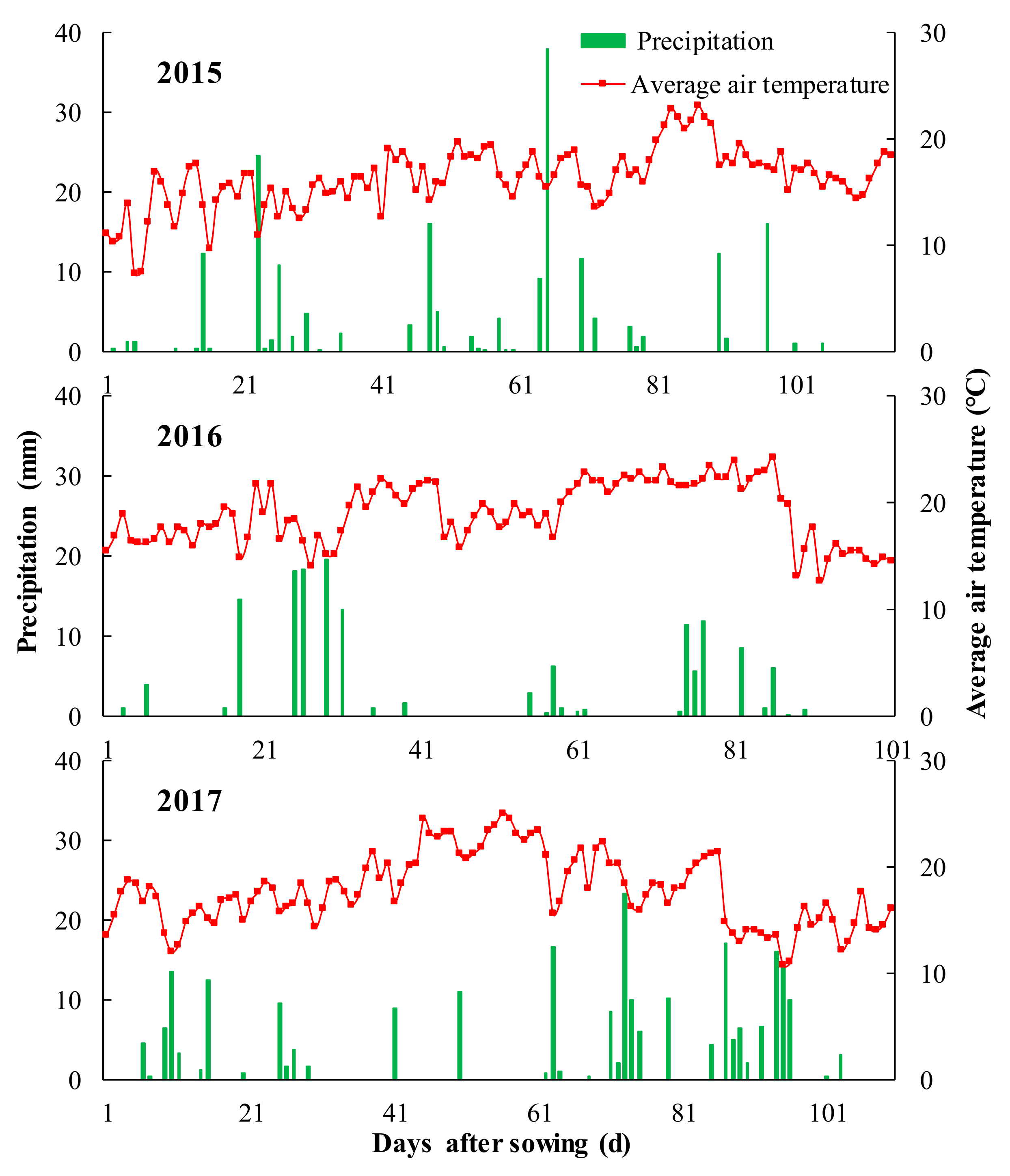
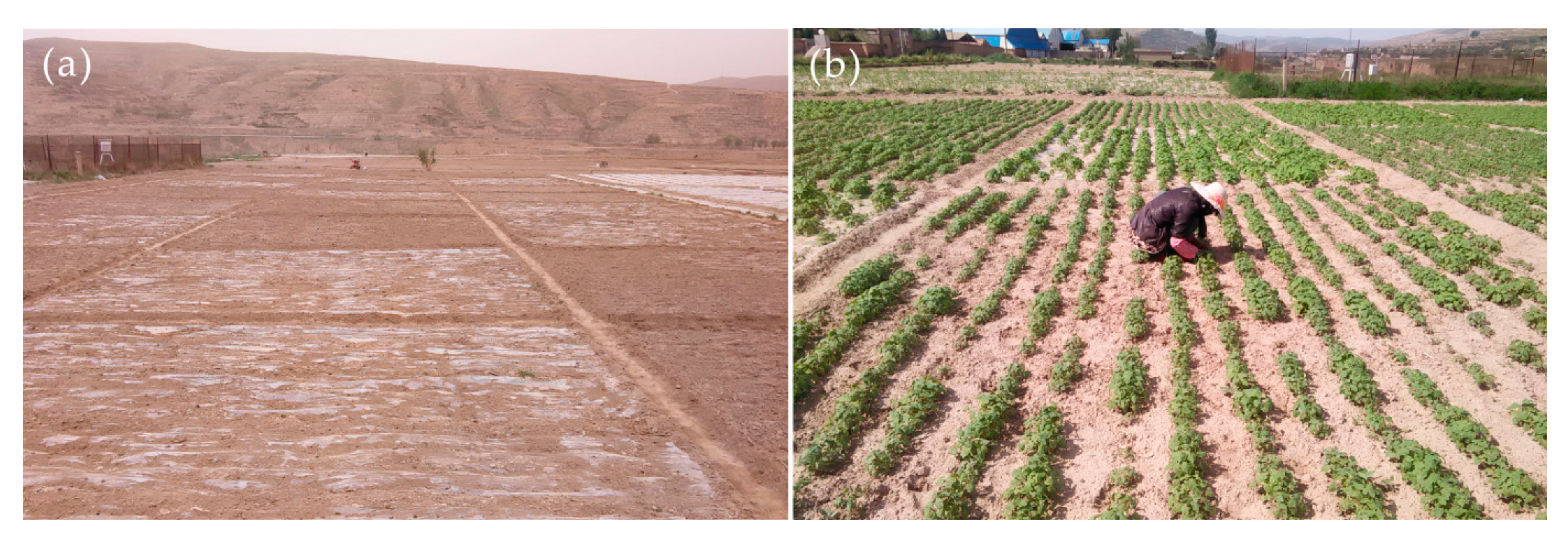
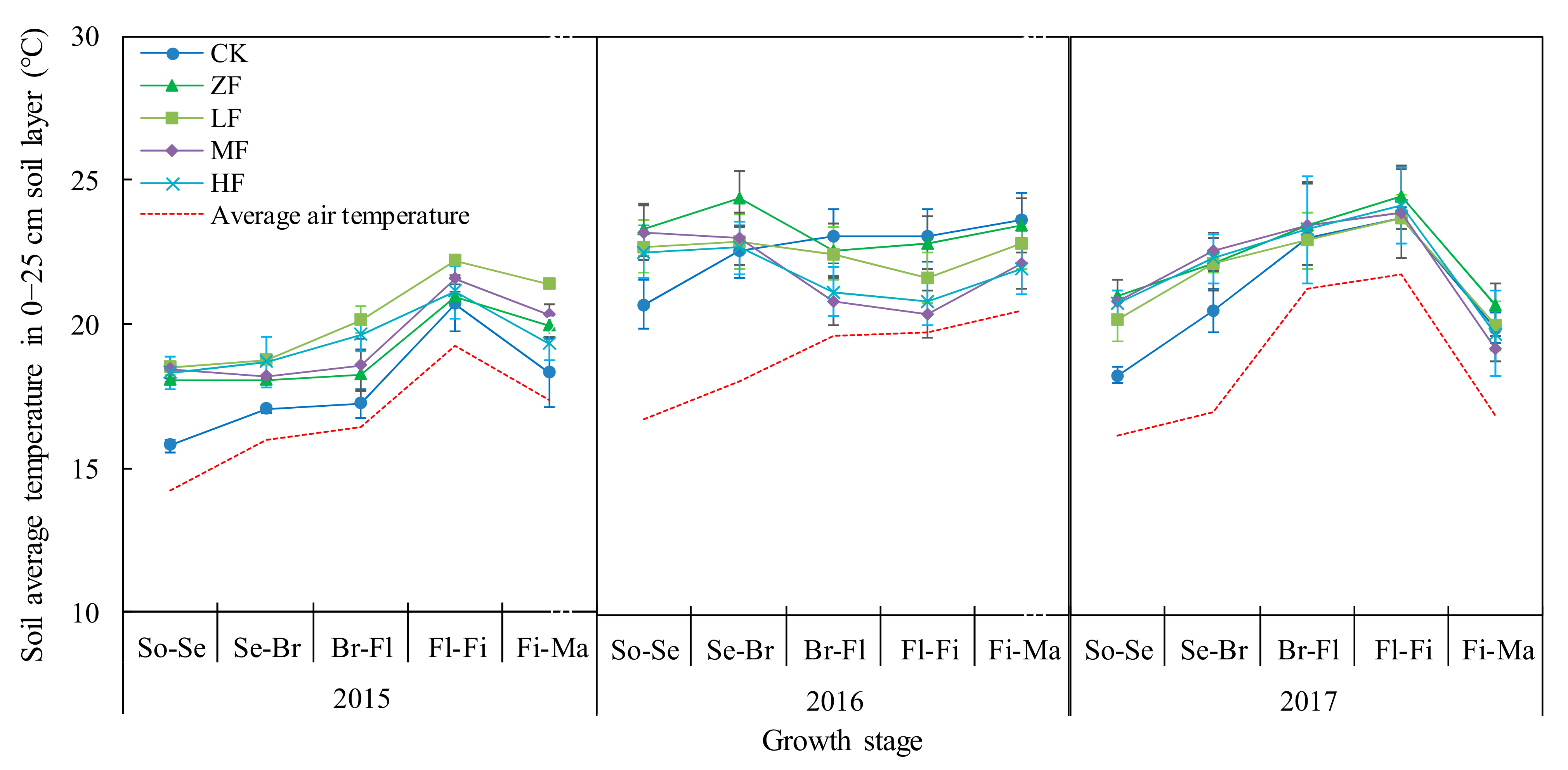

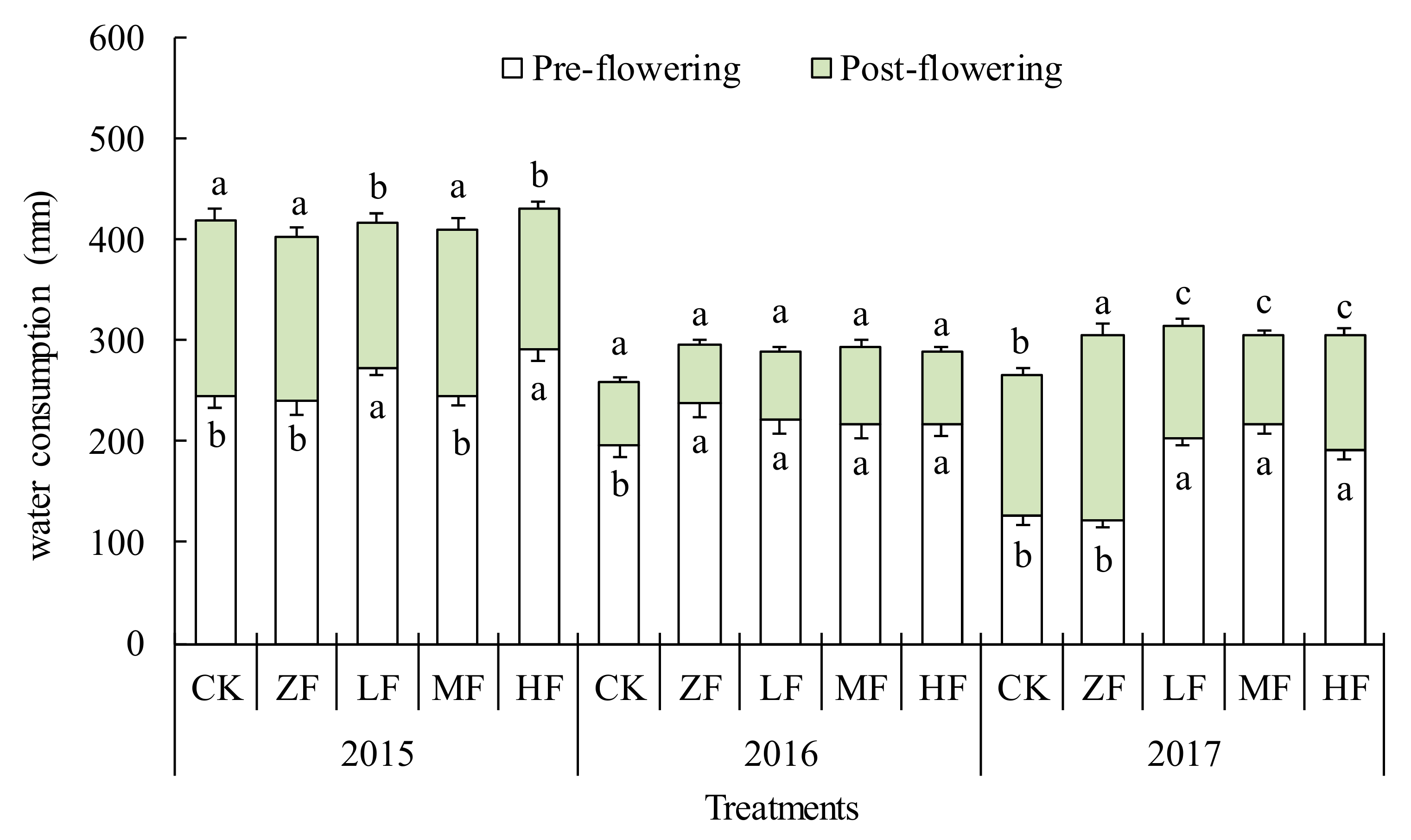
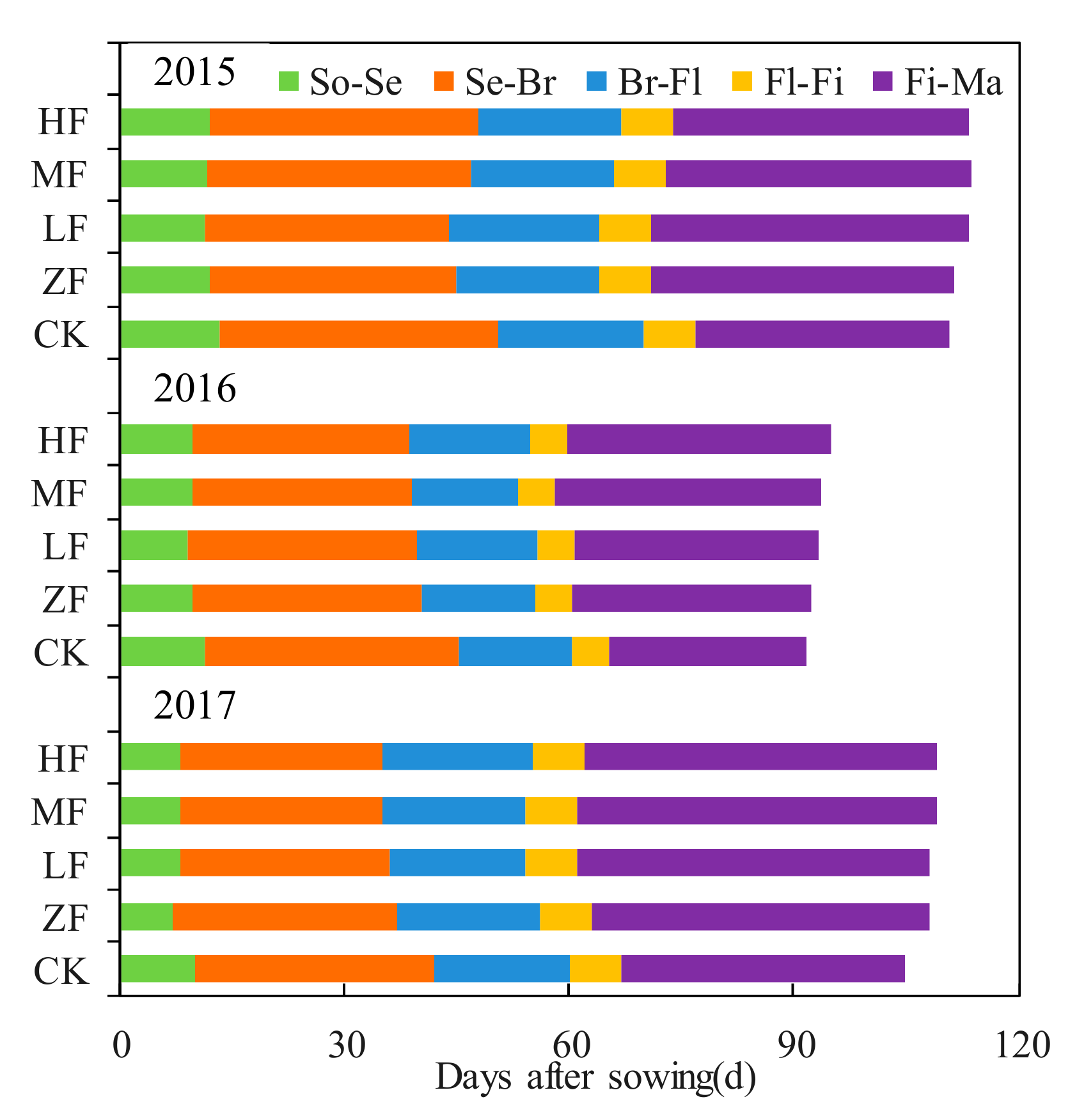
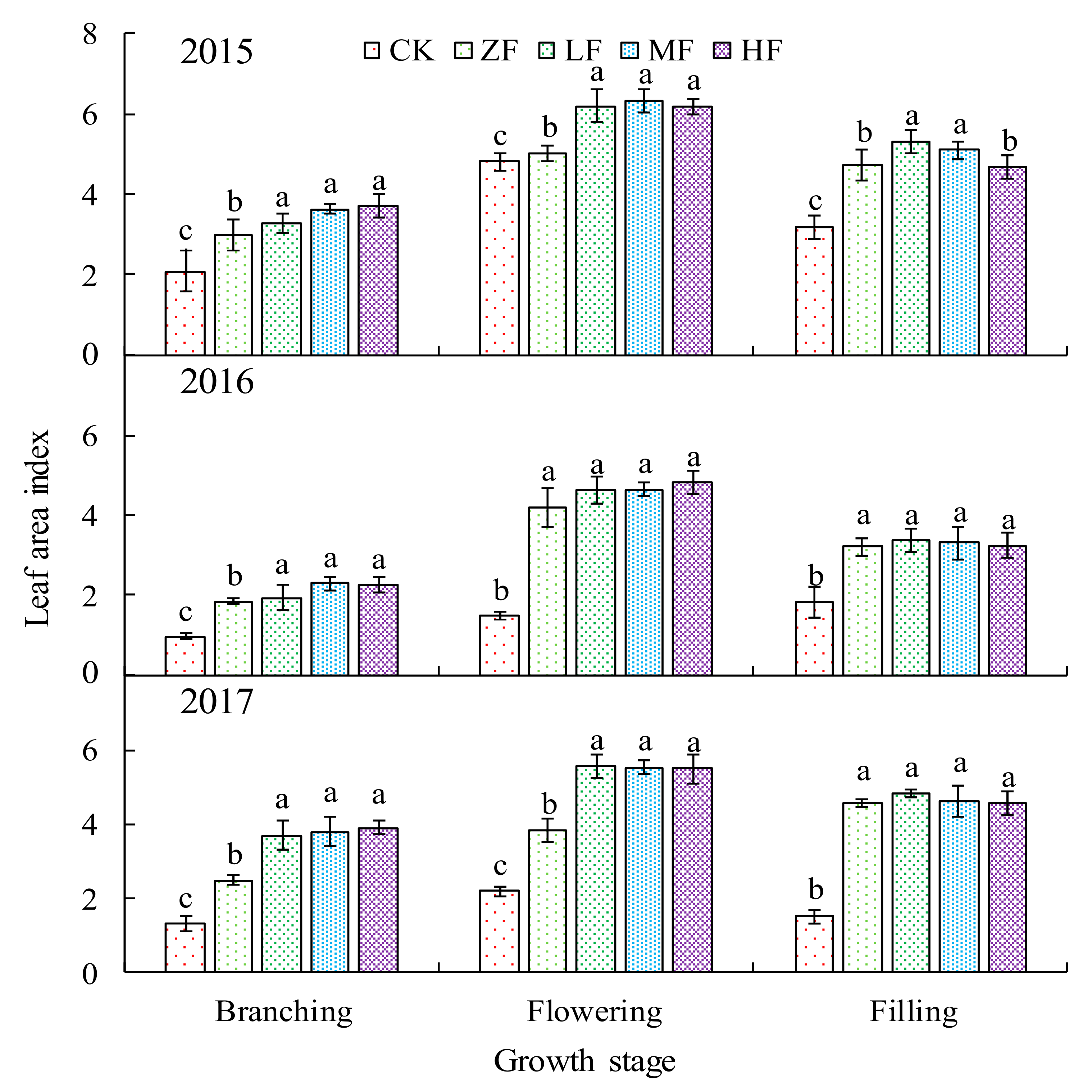
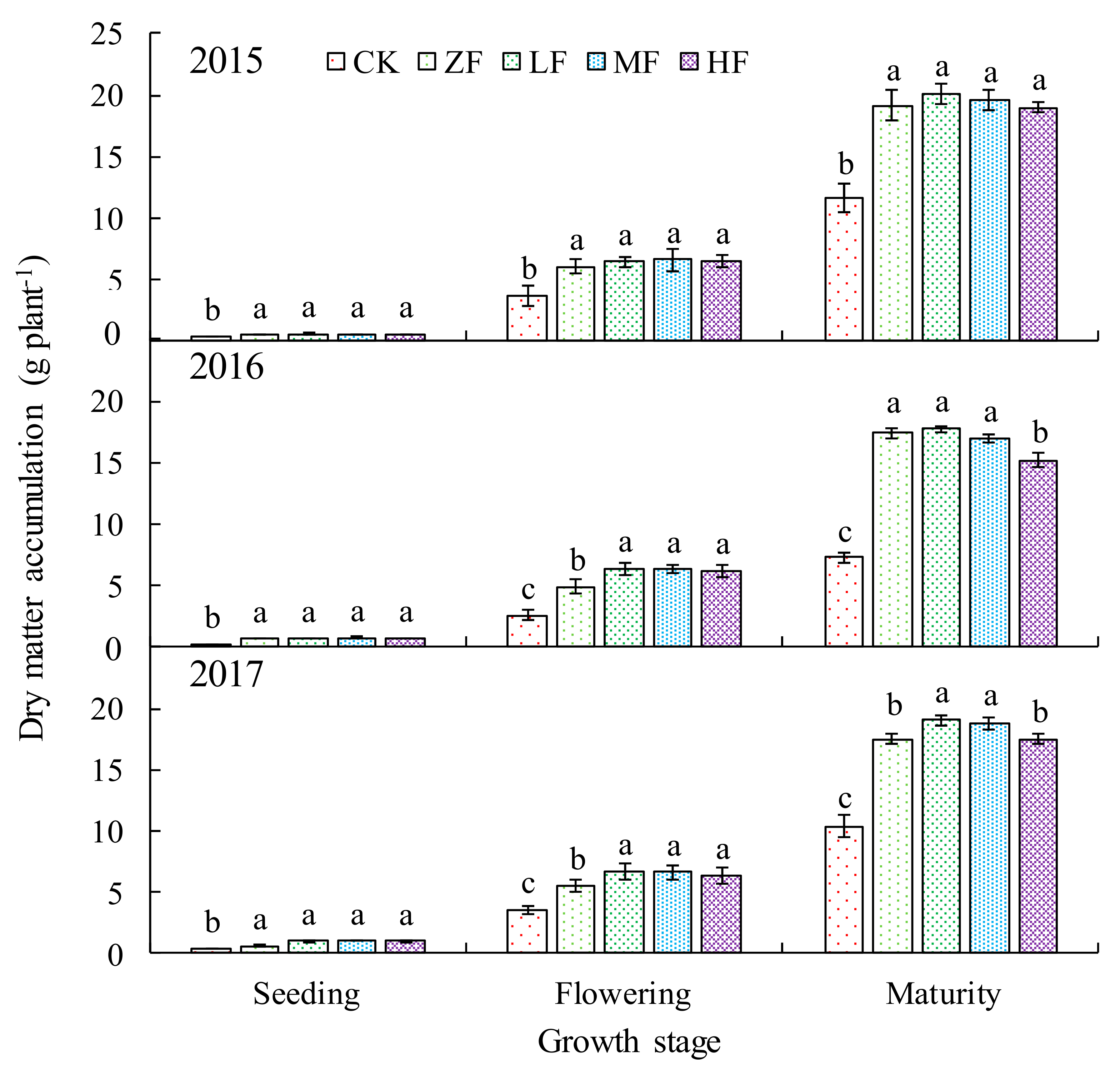
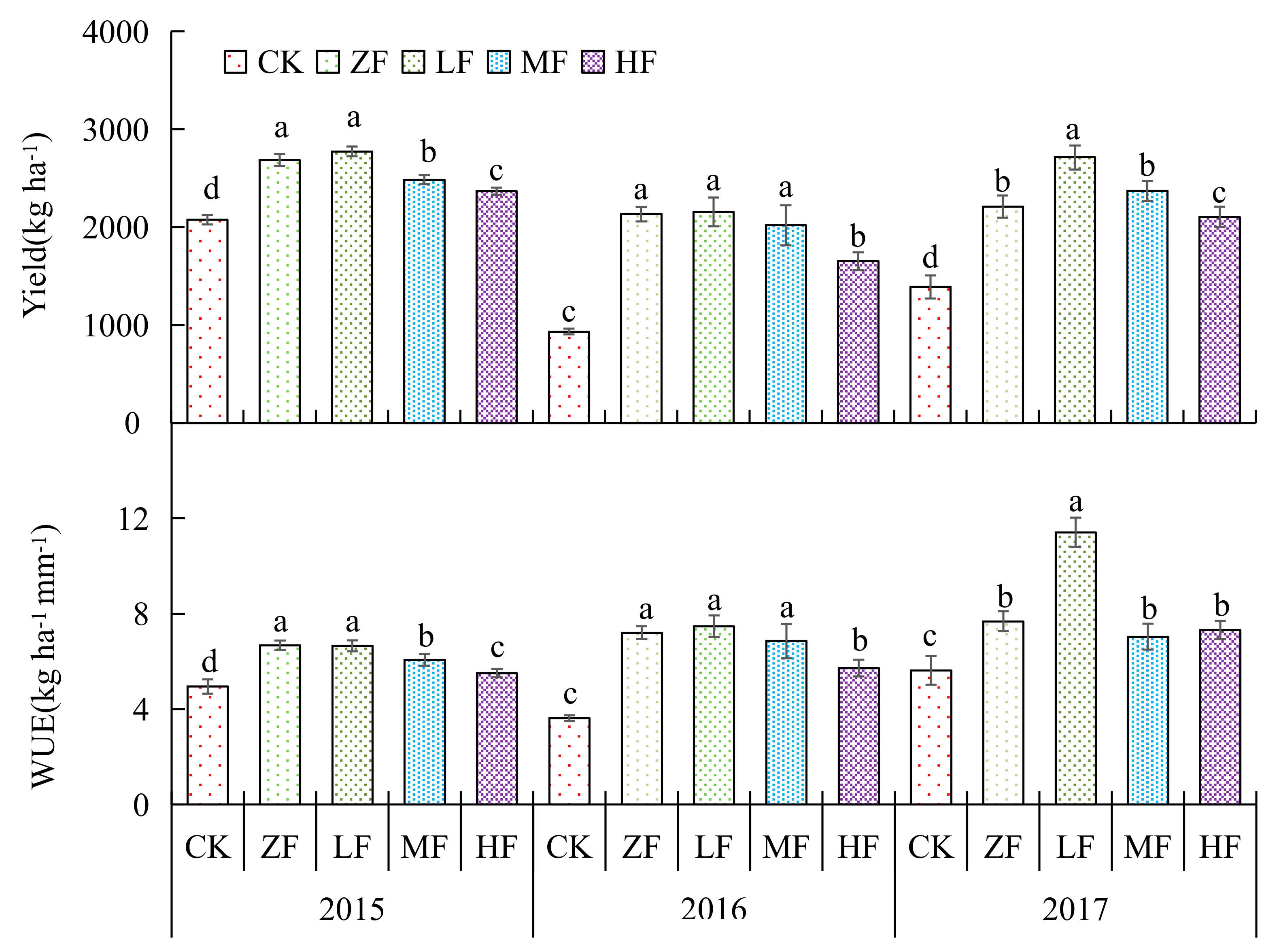
Disclaimer/Publisher’s Note: The statements, opinions and data contained in all publications are solely those of the individual author(s) and contributor(s) and not of MDPI and/or the editor(s). MDPI and/or the editor(s) disclaim responsibility for any injury to people or property resulting from any ideas, methods, instructions or products referred to in the content. |
© 2023 by the authors. Licensee MDPI, Basel, Switzerland. This article is an open access article distributed under the terms and conditions of the Creative Commons Attribution (CC BY) license (https://creativecommons.org/licenses/by/4.0/).
Share and Cite
Fang, Y.; Yu, X.; Hou, H.; Wang, H.; Ma, Y.; Zhang, G.; Lei, K.; Yin, J.; Zhang, X. Growth Response of Tartary Buckwheat to Plastic Mulching and Fertilization on Semiarid Land. Appl. Sci. 2023, 13, 2232. https://doi.org/10.3390/app13042232
Fang Y, Yu X, Hou H, Wang H, Ma Y, Zhang G, Lei K, Yin J, Zhang X. Growth Response of Tartary Buckwheat to Plastic Mulching and Fertilization on Semiarid Land. Applied Sciences. 2023; 13(4):2232. https://doi.org/10.3390/app13042232
Chicago/Turabian StyleFang, Yanjie, Xianfeng Yu, Huizhi Hou, Hongli Wang, Yifan Ma, Guoping Zhang, Kangning Lei, Jiade Yin, and Xucheng Zhang. 2023. "Growth Response of Tartary Buckwheat to Plastic Mulching and Fertilization on Semiarid Land" Applied Sciences 13, no. 4: 2232. https://doi.org/10.3390/app13042232
APA StyleFang, Y., Yu, X., Hou, H., Wang, H., Ma, Y., Zhang, G., Lei, K., Yin, J., & Zhang, X. (2023). Growth Response of Tartary Buckwheat to Plastic Mulching and Fertilization on Semiarid Land. Applied Sciences, 13(4), 2232. https://doi.org/10.3390/app13042232




